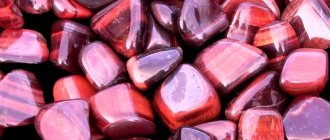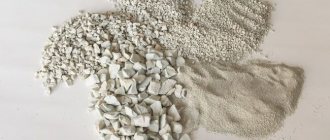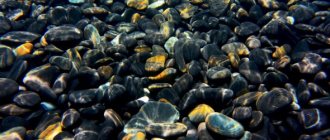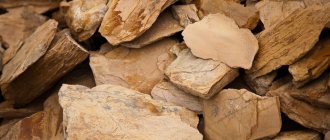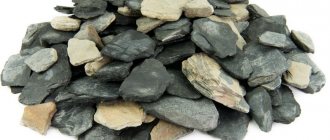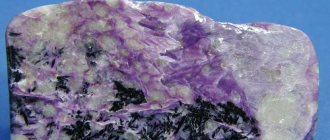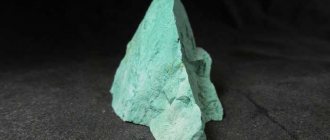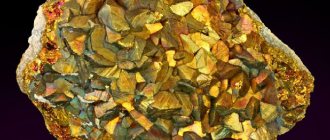This stone belongs to the spar family. It is used in a wide variety of sectors of human life. This includes the making of ceramics and jewelry, magic, and alternative medicine. We will talk about all this in our article. You will also learn how to use the mineral as a talisman, and who it will suit.
History of the mineral
Albite is one of the few minerals whose “parents”, history of name and date of birth are known.
These are geologists Berzelius and Hahn, who discovered an unknown mineral in their native Sweden in 1815. The choice of name was determined by the color: the Latin albus means “white”.
Since the mineral was not suitable for precious or semi-precious stones, practical Europeans were not particularly interested in it. Only a century later, the guru of Soviet mineralogy, Alexander Evgenievich Fersman, did this. The stimulus was the discovery near the White Sea of unknown spars with iridescence from grayish blue to blue violet. He named the stones Belomorites.
Albite stone
Albite also appears in the literature as white feldspar, albiclase, and white schorl.
Physico-chemical characteristics
Albite is an aluminosilicate from the group of feldspars (a subgroup of plaxioglas).
Characteristics of the stone:
- chemical formula – NaAlSi3O8;
- hardness on the Mohs scale – 6.1–6.4;
- shine – glass;
- the fault is conchoidal, uneven;
- crystal shape – tabular, needle-shaped;
- transparency – full, medium, zero;
- interaction with acids - soluble only in hydrofluoric acid;
- interaction with alkalis – zero;
- fragility – high;
- melting point – 700–800 °C, depending on the variety;
- colors – white, colorless; red, purple, golden, yellowish, grayish-brown tones.
The color richness is created by the elements that make up albite: chromium, lead, calcium, magnesium.
The formation of albite crystals takes decades. When heated, their structure is deformed.
Deposits, mining sites
The first location of albite was noted in Sweden, at the beginning of the 19th century.
Albit is not a unique mineral; its deposits are located all over the world, but pure rock is very rare, and therefore is especially valued by collectors.
A pure breed can be quite difficult to spot.
As a rule, albite is mined in conjunction with other minerals. Albite is mined in different parts of the planet, depending on what it will be used for.
For the jewelry industry, transparent crystals of the mineral are used, which are found in Africa. These are Kenya, Zimbabwe, Madagascar. For industrial use, albite mined in America is used, in states such as Pennsylvania and Georgia. There are quite large albite deposits there.
Russia is also characterized by huge deposits of this mineral. The main places of production are Irkutsk and the Urals. It should be noted that albite is also widely popular among collectors. This applies to clevelandite - lamellar albite. Its deposits are located in Transbaikalia.
Large crystals are found in Switzerland and Brazil. The property of iridescence is endowed with minerals that were obtained in the Eastern Pamirs of Tajikistan and Norway.
Where is albite mined?
An industrial-scale mineral deposit was first discovered on the Scandinavian Peninsula, in Sweden.
Over 200 years, the geography of albite deposits has expanded, covering almost the entire planet:
- Africa – Madagascar, Zimbabwe, Kenya;
- America – USA, Brazil;
- Asia - Tajikistan;
- Europe - Russia (Ural, Transbaikalia), Greece, Norway, Switzerland.
Despite the wide distribution of the mineral, finding pure material is problematic: albite is almost always associated with other rocks.
Pure large specimens are supplied by Switzerland and the Brazilian “jewelry” state of Minas Gerais.
The heritage of Tajikistan and Norway are stones with iridescence.
Albit - “moon” stone
This mineral is one of the most common and cheapest on the planet. However, any jewelry with albite can turn its owner into a witch.
What is
Albite is a mineral of the feldspar group. One of the three components of this group, classified as moonstones.
In its pure form it is white, but such options are rare. More often they find bluish, grayish, purple, yellowish, even brownish samples.
Albite crystals are transparent to varying degrees, looking like needles or tables with a glassy sheen.
History of the stone
Albit has been known for centuries. Sorcerers and magicians used it to call the dead for communication. In Ancient Greece it was an attribute of rituals performed by fans of the cult of the Moon.
The mineral has not been studied much by official science.
The Swedes Gottlieb Hahn and Jacob Berzelius were the first - specimens of the stone were discovered in their country for the first time in European mineralogy. By 1815, they compiled a description and proposed a name.
The stones were named Albites based on their color: albus means “white” in Latin.
A hundred years later, the history of the formation and properties of lunar crystals discovered on the shores of the White Sea interested the great Soviet mineralogist Alexander Evgenievich Fersman. At his suggestion, a variety of albite with an iridescence of sky-violet shades was called belomorite.
Physical and chemical parameters
According to scientific classification, albite stone is an aluminosilicate from the plagioclase subgroup.
Its basic composition includes silicon, aluminum, sodium, oxygen. These four elements create the formula and pure "moon" stones.
Plus impurities. A small amount of calcium, potassium, and magnesium determines the degree of saturation and variety of shades for which albite is famous.
We recommend: HAWKEYE - the universe is looking at us
Formula Impurity Physical properties Color Feature color Luster Hardness Cleavage Fracture Density Crystallographic properties Syngony
| Na[AlSi3O8] |
| K, Ca, Rb, Cs |
| White gray |
| White |
| Glass |
| 6 — 7 |
| Perfect by {001}, average by {010} |
| Uneven, conchoidal; fragile |
| 2.61—2.63 g/cm³ |
| Triclinic (primitive) |
The stone is indifferent to heat and chemicals (except hydrofluoric acid).
Production regions
Albite, a stone of the feldspar group, is one of the most common rock-forming components of the igneous type.
Albite deposits are scattered throughout the planet:
- Africa – Kenya, Madagascar, Zimbabwe.
- Europe – Norway, Switzerland.
- America – Brazil, USA, Canada.
- Asia - Tajikistan.
Russia – Kola Peninsula, Transbaikalia, Irkutsk region, Northern Urals.
Each mineral deposit produces different raw materials:
- Transparent crystals of jewelry quality come from the African continent.
- The breed of American origin is suitable for industrialists.
- The Pamirs and northern Norway are a source of large stones with an iridescent effect.
- Switzerland and the Brazilian jewelry state of Minas Gerais are famous for their huge crystals of high purity.
Varieties of mineral
The nature of the structure and description of the color determined the varieties of the mineral:
- High. The structure of the stone is chaotic, the crystals are indifferent to thermal influences (they do not melt up to 790 °C).
- Short. The crystals are ordered, but the thermal stability threshold is lower (melting at 710 °C).
- Peristerite. Blue or light blue translucent crystals. They are also recognized by iridescence or adularization. The variety of stone is named after the largest deposit in Greece - the Peristeri mountain range.
- Belomorit. Russian wealth. The mineral is named after the place of its first discovery - the coast of the White Sea. It is mined in the north of Russia. It differs from peristerite in its rich color range: blue-, gray-blue, violet crystals.
- Clevelandite. The structure makes the stone look like a layer cake. Named after the mineralogist Professor P. Cleveland.
- Periclin. White raw material, identified by very long light needle crystals.
The peculiarity of albite is that when used in a specific industry, the type of mineral matters.
Description
Albit (from Latin albus - white, in color, English albite) is a white silicate feldspar. The shade of this fossil may vary depending on where it is mined.
It is known that this spar can be different; it is found in bluish, grayish, violet, gold, brown, yellow, and orange colors.
Depending on the chemical additives, the color of albite is saturated or pale.
The crystals that make up this mineral are characterized by an opaque structure with a glassy shimmer. This is a very interesting and multifaceted mineral. It is recommended to place albite amulets and talismans above the door; this serves as a certain protection against the influence of dark forces on the house. Products made from albite help give the owner peace of mind. Several types of mineral are known.
Types and subspecies of the breed
There are the following types:
- High albite is a representative with a chaotic structure that does not melt even at very high temperatures;
- Low albite has an ordered internal structure and withstands high temperatures;
- Cleavelandite - lamellar albite, mainly distributed in pegmatites, received its name thanks to the scientific research of Professor P. Cleaveland;
- Pericline is a type of stone with long light crystals, its deposits are often alpine-type veins;
- Peristerite is a partially translucent albite, characterized by iridescence or, not rarely, adularization.
Characteristics of albite, chemical and physical properties
Albite contains a large number of different elements:
- aluminum;
- sodium;
- silicon;
- oxygen.
These are the main elements; albite also contains chromium, lead, potassium, calcium and magnesium in lower percentages, which directly affect the shade of the rock.
The basic chemical formula that represents albite is Na[AlSi3O8].
It should be noted that the crystals that make up the mineral tolerate melting, heating, and exposure to chemical mixtures well. The only acid that can change the structure of a mineral is hydrofluoric acid. It is believed that albite forms over many years.
In cross-section, the crystals are uneven and conchoidal. Their shape is tabular or lamellar; sometimes twin and fan-shaped species are found. Frame crystal lattice. Cleavage - from weak to optimal.
Properties
- Point group 1 - Pinacoidal;
- Density (computational): 2.6115;
- Density (obtained in practice) 2.59 - 2.66;
- Specific Gravity: 2.62;
- Dispersion of optical axes: r
- Optical relief: low;
- Structural features: tabular crystals, fine-needle crystals;
- Classification according to USSR standards: Silicates;
- IMA classification: Silicates;
- Triclinic system;
- Color range Colorless, white to gray, bluish, reddish;
- Line color: white;
- Shine; glass;
- Transparency: transparent translucent cloudy opaque;
- Cleavage perfect according to {010};
- Cut: conchoidal, uneven;
- Hardness on the Mohs scale: from 5.9 to 6.6;
- Fragility: Yes;
- Heat Sensitivity: Almost impervious to high temperatures, resulting in yellow flame when exposed to fire;
- IMA category: existing, designated for the first time after the mid-19th century (before IMA);
- Characteristic mixtures: Ca, K, Mg;
- Molecular weight: 263.02;
- Number of formula individuals (Z): 4;
- Plain grain volume: V 667.19 ų;
- Twinning: polysynthetic twins according to certain standards.
Deposits, mining sites
The first location of albite was noted in Sweden, at the beginning of the 19th century.
Albit is not a unique mineral; its deposits are located all over the world, but pure rock is very rare, and therefore is especially valued by collectors.
A pure breed can be quite difficult to spot.
As a rule, albite is mined in conjunction with other minerals. Albite is mined in different parts of the planet, depending on what it will be used for.
For the jewelry industry, transparent crystals of the mineral are used, which are found in Africa. These are Kenya, Zimbabwe, Madagascar. For industrial use, albite mined in America is used, in states such as Pennsylvania and Georgia. There are quite large albite deposits there.
Russia is also characterized by huge deposits of this mineral. The main places of production are Irkutsk and the Urals. It should be noted that albite is also widely popular among collectors. This applies to clevelandite - lamellar albite. Its deposits are located in Transbaikalia.
Large crystals are found in Switzerland and Brazil. The property of iridescence is endowed with minerals that were obtained in the Eastern Pamirs of Tajikistan and Norway.
History of the stone
Albit has never been appreciated as much as it deserves. But its healing and magical abilities are still valued and used in all countries of the world.
In Ancient Greece and India, albite was used to carry out all kinds of rituals and ceremonies. This stone was used for the complex ritual of summoning the dead and communicating with them.
There was also a legend that with the help of albite you can control the heavenly bodies. This has not been proven and remains at the level of myth. But interest in the stone has increased.
In the 19th century, the stone acquired the name that has survived to this day. This was done by Swedish specialists. Afterwards, a Russian geologist began studying the stone and discovered a species that was not similar to previously found stones with a bluish and violet glow. A mineral with such properties is called belomorite.
Scope and scope
Albite is an interesting mineral, characterized by its dual structure. This mineral is used in gemological knowledge of the process of metamorphism, because it is one of the main components in the creation of rocks.
This spar is widely used to create beautiful jewelry in the jewelry and ceramics industries. Since it is characterized by such properties as hardness, resistance to abrasion and heat.
In the jewelry industry, albite falls under the category of "moon" stones. This mineral is rarely used. Various jewelry is made from high-quality processed rock.
In the construction industry, it is used as a finishing agent both inside and outside the building.
Albite is believed to have certain magical and healing properties. Widely used in folk medicine.
Decorations
Looking at pictures of feldspar, it is difficult to assume that it is a precious stone. As a rule, the rock is cut for collectors. But it is also used in the manufacture of various jewelry, such as beads, bracelets, earrings, and rings. As a rule, only albite crystals are used to make jewelry. The cut is made in the form of a cabochon.
Where is the mineral used?
Albite is one of the “youngest” minerals for humans. However, the physicochemical properties of albite and its color range ensured its demand and use in various fields:
- These are test samples for studying metamorphic processes. This was influenced by the origin of albite and the participation of the mineral in their formation.
- The albite mineral is a good component that gives traditional finishing materials a new “sound.” Plus refractories and abrasives, an additive to concrete for strength. The industry is in demand for durable American and Russian stones.
- The mineral is quite hard, resistant to heat and abrasion. Therefore, kitchen ceramics containing albite are famous for their reliability and durability.
- Jewelers classify albite as a “moon” stone. Favorites include transparent or translucent minerals from the Black Continent and specimens with iridescence (that is, iridescent iridescence). The ideal cut for albite is a flat cabochon.
Collectors look for druses of unusual shapes or combinations of stones. Clevelandite is especially desirable as a collection stone. It is found in Transbaikalia, the Swiss Alps, Norway, and the Pamirs (Tajikistan).
Application
The areas of application of albite are quite diverse, despite the fact that the mineral was discovered relatively recently. The properties that its unique structure gives it are in demand among a variety of people.
- Gemologists who study stones use white spar to study the processes of metamorphism in rocks.
- Ceramics are made from albite. It is quite hard and withstands abrasion and heat well, so kitchen utensils made from this mineral are of very high quality.
- Jewelers use albite to create jewelry. Stones that play with different colors of the rainbow are especially valued (scientists call this process iridescence). White spar is ground into flat cabochons.
- Minerals that are not suitable for jewelers are used to create costume jewelry.
- Builders value white spar as a finishing material that gives buildings a special flavor.
White spar is used in alternative medicine. It is also appreciated by magicians and sorcerers. The esoteric scope of application is so wide that we will devote a separate section to it.
Price
The price of albite is low. It is determined by the type, degree of processing, weight (price, thousand rubles):
- ball, 4.5 cm – 4.9;
- egg, 5.5x4 cm – 3.8;
- schorl with albite – 4.1–4.2;
- tourmaline in albite – 2.8–9.8.
Jewelry almost always contains a variety of the mineral belomorite (cost, rub.):
- pendant – 490–560;
- bracelet – 780-1 390;
- necklace – 1,590-2,390;
- silver ring – 1,650;
- earrings (nickel silver) – 780.
These are the prices of Russian online stores.
Reviews
According to reviews from those who have tried this fertilizer, the advantages include:
- Increases the yield of all major crops by 10-35%.
- Increases plant resistance to drought and other unfavorable environmental factors (stress)
- Neutralizes the stressful effects of chemical pesticides and fertilizers,
- Increases field germination of seeds
- Reduces the period required for plants to form a harvest,
- Improves product quality (increases the gluten content of wheat by 0.5–5.1%)
- Increases plant resistance against a wide range of diseases (root rot, septoria, leaf rust, powdery mildew, net spot, bacteriosis, late blight, etc.).
- Low cost.
How to identify a fake
Instead of beautiful minerals, they offer ordinary feldspar, glass or plastic.
The properties of natural albite help to distinguish a fake and establish the authenticity of a sample:
- Infusibility. A fire (match or lighter) is brought to the sample. The plastic will melt, but the stone will not be damaged.
- Interaction with acids . Sulfuric or hydrochloric acid is dropped onto the sample. Nothing will happen to a real stone.
- Thermal conductivity. Mineral, unlike plastic or glass, does not immediately heat up in your hands.
Ordinary specimens of white spar are cheap and are rarely counterfeited. Transparent, colored or “layered” stones are a completely different matter.
Origin and location
Albite is widely distributed in acidic and alkaline rocks, especially in pegmatites, hydrothermal veins and voids among rocks, as a metamorphic formation in gneisses and crystalline schists, as an authigenic formation in limestones and limestones transformed into marbles, and also as Na- perthite phases in decomposed K,Na-feldspars Often a rock-forming mineral of granites, syenites, keratophyres, gneisses, chlorite schists. It is found in cracks as a mineral of hydrothemal origin, sometimes in druses with numerous accompanying minerals. Albite is ubiquitous in folded basement rocks. Particularly beautiful druses are found in Alpine veins.
Albit crystals in quartz with epidote Ural
Magical properties of the stone
Albit is a stone of the water element, under the auspices of the Moon. Its magical power waxes and wanes synchronously with the phases of the luminary.
The Sibyls of Ancient Greece and Indian magicians used albite in risky rituals. For example, summoning the dead and communicating with them. It was believed that the mineral helped to “guide” the course of the stars.
Today, the magical properties of the stone help in the following situations:
- People associated with water or sea (trawlers, cruise ships, solo fishermen).
- Travelers, geologists, business people on trips.
- The stone will prevent emotional burnout, anxiety, and insomnia. It will bring you out of depression, extinguish aggression, unmotivated irascibility.
- Albit above the front door will protect the house from the influence of dark forces or people.
Together with moonlight at night and during the day, the stone absorbs solar energy. Thanks to this “omnivorousness,” albite is in demand for occult practices as a balancer, an energy equalizer.
Adherents of Eastern practices see in this the harmony of Yin-Yang.
Treatment options
Traditional healers have found that the healing properties of the mineral are of particular importance for people suffering from ailments of the stomach and related internal organs:
- Gastrointestinal tract;
- spleen;
- liver;
- kidney;
- pancreas.
The mineral heals these organs. To do this, a person must lie down, and the stone is placed on the desired area of the body.
We recommend: TOP 9 CHALcedony stones
After use, the mineral is cleaned of the collected negativity. That is, pour cool water (not from the pipeline) for half an hour.
How to wear jewelry with albite
Esotericists are sure: products with stones are not just a beautiful accessory:
- A bracelet or ring on the left hand, a brooch on the left side stimulates the achievement of external harmony (with the world and people).
- Accessories on the right hand or side allow you to contact your own inner world.
In this way, you can receive hints or help from the stone.
Emotional people are advised to wear two talismans with albite of different colors. They need to be charged, respectively, with solar and lunar energy.
A little bit of magic
The crystal, in addition to healing properties, is also endowed with magical properties. Since ancient times, astrologers, magicians and wizards have used it for various purposes. For example, astrologers claim that this mineral is an excellent conductor of energy between the Sun and the Moon. In this regard, magical rituals require the presence of at least 2 copies. Practicing magicians use plagioclase to relieve a person of stress, nervousness, and tension.
An amulet with albite is recommended to be worn by people who are particularly emotional and susceptible to external irritants. However, in a single copy its impact will be very weak. That is why it is desirable that the amulet consist of a pair of stones. A pair of them will contribute to the acquisition of wisdom and clarity of mind by those who own them. Such talismans have significant power. It is recommended for those who like to travel to have this mineral with them. With its help, a wandering person will be able to avoid various dangers.
Chinese tradition uses the described mineral to create harmony in the inner world of a person and his environment. It is believed that to achieve such harmony, a person needs to possess the energies of Yin and Yang in the same ratio. If there is an excess of one of the forces, it is necessary to normalize it by adding the force that is missing. Thanks to lunar albite, you can attract Yin energy, and with the help of solar albite, you can attract Yang energy.
To give the stones the appropriate strength, one of them should be charged with the light of the Moon, and the other with the light of the Sun. It is important that lunar plagioclase is laid out on the windowsill during the new moon. In addition, you need to ensure that moonlight falls on the crystal. To preserve its magical properties, it is recommended to put the pebble in a dark place during the day, for example, in a box. Similar actions are performed with solar albite only during daylight hours.
The crystal, in addition to healing, is also endowed with magical properties.
This mineral is endowed with other magical qualities. Thus, thanks to him, a person learns a philosophical attitude towards everything that happens in his life. It benefits not only the person, but also his home. For example, there is an opinion that if you place a crystal on the front door of your home, it will be cleared of external negativity. In this case, the magic stone should be located on the outside of the door.
Plagioclase belongs to the water element, its miraculous properties are associated with the lunar cycles of ebb and flow. This circumstance made the mineral a symbol of the infinity of life. Interestingly, there is no specific zodiac sign that it suits. It can be worn as an amulet by water, fire, air, and earth signs. However, some astrologers still recommend plagioclase to the signs of Water (Scorpio, Cancer, Pisces) and Leo.
Thus, albite is a mineral that can be used for medicinal and magical purposes. Its advantage is its low price compared to precious and even semi-precious stones.
Mineral care rules
An additional advantage of albite is its unpretentiousness.
The stone does not require specific or particularly complex care:
- It is fragile, so it is better not to drop it or test its strength.
- To store jewelry or samples, allocate a separate box or section in it. If this is not possible, you need to wrap each product in a soft cloth.
- Physical dirt is removed by rinsing the product with cool water (you can use neutral or baby soap). Then blot with a dry soft cloth.
If the stone is used as a magical or healing artifact, the energy mud is neutralized with salt water. You can bury it in the ground for two/three hours.
Lithotherapy
Albit, although not a precious or even semi-precious stone, is widely used in folk medicine. It is used to treat diseases
- internal secretion organs;
- liver, spleen, pancreas, stomach, kidneys.
To get results, you should wear the stone as an amulet or as part of jewelry until the problematic organ no longer reminds you of itself. It is best to apply Albite to the sore spot for at least an hour. Reusing the stone requires first cleaning it, for which it is recommended to rinse it under running cold water.
It is believed that albite will pump into itself all the negative energy that brings pain and discomfort.
Albit by zodiac sign
Water moonstone has a special relationship with half of the Zodiac:
- As a talisman it is suitable for Cancers, Pisces, Aquarius. Balances character traits, leveling out negativity and enhancing winning moments. It will help you make easier contact with other inhabitants of the Zodiac circle, especially fiery ones.
- For Fiery Aries, Sagittarius, Leo, the stone is contraindicated due to energy incompatibility. Albit will strengthen the influence of the Black Moon in their horoscopes and attract problems.
- For other signs of the Zodiac, albite is also suitable as an assistant, although not as powerful.
Table of compatibility of albite with zodiac signs (“+++” – fits perfectly, “+” – can be worn, “-” – is strictly contraindicated).
| Zodiac sign | Compatibility |
| Aries | — |
| Taurus | + |
| Twins | + |
| Cancer | +++ |
| a lion | — |
| Virgo | + |
| Scales | + |
| Scorpion | + |
| Sagittarius | — |
| Capricorn | + |
| Aquarius | +++ |
| Fish | +++ |
Regardless of the recommendations of astrologers, you need to focus on personal compatibility with the stone. If discomfort is felt, it is better to keep it as a collector's item or give it as a gift.
Horoscope
Albit can be used as an astrological talisman by absolutely all representatives of the zodiac system, except for signs of the element of Fire. Leos, Aries and Sagittarius are categorically not recommended to use the energy of the stone, as it has a destructive effect on the character and fate of its owner. Otherwise, this is a “positive” stone that will not harm anyone, but will only bestow peace and harmony.
He especially favors the signs of the Water element (Pisces, Scorpios and Cancers). The mineral will help them establish connections with other representatives of the Zodiac, balance the manifestation of negative and positive character traits, and bring good luck. Other signs can wear albite and use its properties, but their manifestation will not be as pronounced. Back to contents
